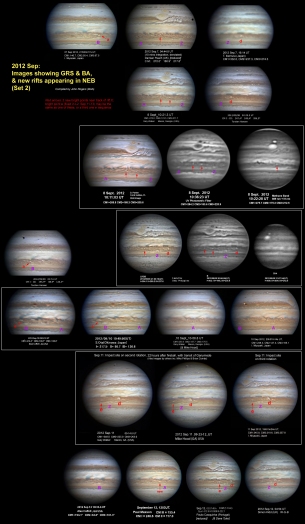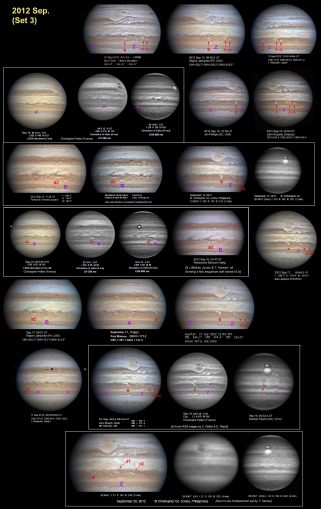


[6]
Renewal
of rift activity in the revived NEB:
This
set of images from 2012 Aug.21 to Sep.30, displayed across 4 panels, shows the
renewal of rift activity in the revived NEB, along with Oval BA passing the GRS,
and other features in that hemisphere.
In
the SEB, note a very dark brown barge at L2=95; the long-lived light spot at
L2=115; the GRS at L2=183, with red oval BA passing it; and the normal energetic
rifting in the SEB f. it.
In
the NEB, note the barges and ovals developing as mentioned in our previous
report.
The 4th panel includes a chart showing their drifts, derived
from the JUPOS teamís charts.
The three anticyclonic ovals are still light grey rather than white, but
we refer to them as white spots B, A, and Z, as in our previous report.
They are at 19 deg.N.
WSA and WSZ are rapidly prograding.
The barges are much smaller, dark spots, slow-moving, at L2~35, 70, 112,
140. WSA
passed the last barge around Sep.10-12, as is nicely shown in the images (the
barge became a tiny dark point at the time).
The
main novelty is that, since late August, new bright spots have been appearing
within the NEB, which was previously devoid of bright spots or rifts due to the
small-scale turbulence of the NEB Revival. Several
observers pointed out these small, bright white points and remarked that they
were exceedingly bright.
They stand out particularly in blue or UV images.
Nevertheless, they are only weakly methane-bright even at their first
appearance (one on Sep.8, one on Sep.16), and are otherwise not methane-bright;
so they are not shooting up very high.
These
brilliant white points expand over a few days, as usual, into curling rifts,
which become more complex but less bright. They drift at ~-2.0 deg/day in L2.
But later, new brilliant white points sometimes appear on the same track.
So the 5 spots/rifts labelled on the images (a,b,c,d,e) seem to be the
persistent loci even though successive bright points appear within them.
The bright points range in latitude from ~12.5 to 14 deg.N.
Is
there any relationship between the bright points and the barges?
The first bright point (a) was first distinctly seen on the S edge of the
barge at L2=112 (Aug.21).
But thereafter, there is no sign of any relationship.
Often a bright spot has a very dark brown N rim, similar to a barge in
colour and latitude, even when there is no persistent barge there.
On two occasions, a brilliant white point appeared to be almost
stationary in L2 (and almost exactly N of the GRS!) for several days: spot e
(Sep.8-13 or 11-13) and spot d1 (Sep.22-29).
This might be due to their northerly latitude at the time (14 deg.N) .
Or, each might represent a sequence of very short-lived plumes instead of a
single static one.
These new rifts may be a renewal of the usual rifting activity in the NEB, which along with the new barges and ovals, is another sign that the NEB Revival is complete, although one-third of the circumference still lacks any of these spots. All these classes of spots will probably continue to develop over the coming months.
Click images below for full resolution images.
_________________________________
John H. Rogers, Ph.D. Jupiter Section Director,
British Astronomical Association
jhr11@cam.ac.uk
http://www.britastro.org/jupiter/